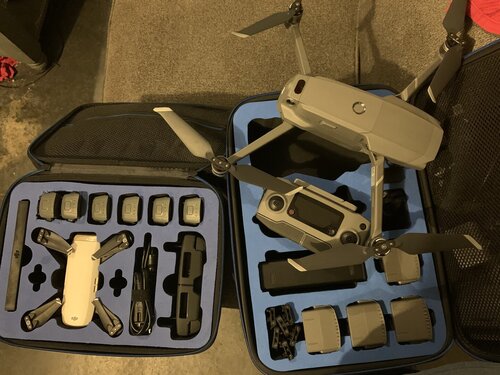This is more curiosity than anything, as I probably won't be able to get into drones anytime soon, but what factors are y'all looking at when you decide what brand/type of drone to buy? I'm assuming that, much like ham radios and aftermarket car parts, certain manufacturers are of higher quality and/or more reliable?
Drew, I am by no means an expert either. However, I’ve been flying unmanned aircraft recreationally for many years now, and commercially for a little over a year now. With roughly 2,900 hours flight time logged (as of tonight’s flight.) on my DJI account/products and as a part 107 cert and the old 333, with night waiver and BOVLOS, I’d like to think I have some pretty good knowledge on the topic. I fly every day and utilize my drones for work and play - your question is probably the question everyone who is getting into the hobby should be asking but aren’t.
You hit the nail on the head likening it to ham radio etc...
The best advise I can give you if you are looking at getting into the hobby or purchasing your first drone:
1) Stay away from WiFi drones.
2) Make sure the drone is/has GPS and or GLONASS
3) You get what you pay for (just like anything else)
4) DO NOT DO A MAIDEN FLIGHT MILES OUT!!! I cannot stress that enough. I’m not picking on Todd, but don’t do it. Keep it within line of sight (it’s not only law, it’s safe) And whether you are a hobbyist or get a cert - know and understand the basic rules - 400ft (AGL - exceptions to this rule) Max flight deck VFR, 3 statue mile visibility, know what class airspace you might be in, NOTAMs, DROTAMs, TFRs, Can’t fly over people, traffic, no night flight (unless you have a waiver and proper lights) BOVLOS - NO Beyond Visual Line Of Sight unless you have a waiver, a total understanding of the basic airman’s knowledge test etc..etc...I worked hard to get my BOVLOS and night waiver. But what the FAA is really starting to crack down on right now, and what you should know is what constitutes a hobbyists and commercial. It isn’t just the 250gram weight of the drone....If you intend on making ANY financial gain from your drone you need to have the 107. A good case scenario would be if you have a monetized Youtube channel and you are flying recreationally but posting videos that garner financially. That’s a big no no.
5) Brand wise, there are a number of different “brands”. Much like Kenwood, Icom etc. You get what you pay for as mentioned. But I like having something that is capable of not only flying with full GPS, but something I can turn the GPS off or fly in attitude mode. This will help you ultimately in a possible flyaway situation.
Much of the rest is pretty much what you want or are planning on doing with your drone. Warren stated he did some testing for DJI, while I don’t recall his name as a beta tester, I’m sure that he would agree that DJI no doubt has majority lock on drone sales around the world. I have done a number of beta tests for them and Yuneec. In fact, Yuneec sponsored us with a grant for the acoustic/infrasonic research back in 2018/2019. But there are also a few other brands that probably should be mentioned that have some great qualities as well:
Autel
Skydio
Yuneec
The flavor you want kinda depends on exactly what you intend to do with drone.
It should be noted that with the new FAA proposed rule making that just took place regarding Remote ID - this is pretty much a middle finger to the general hobbyist. I mention this only because it WILL eventually cause issue for those just getting into the hobby or those trying to make a profession out of it.
I hope I have helped to answer a few of your questions but if you have any more, feel free to ask away. I’ve attached a pic of a couple drones that I fly - I couldn’t get all 4 of them in a close up pic. But you’ll probably notice a lot of batteries. One last thing in closing - drone batteries are LIPO batteries and are extremely dangerous. While all of the batteries you see in the pic for each drone is a “smart” battery, they can and do fail for a variety of reasons. I highly recommend a lipo bag for each battery you have, especially when transporting them. Prior to each and every flight I go over my flight prep - the first thing I check ALWAYS is the shape my batteries are in. Hot and cold can and will do a number on them. Proper maintenance is key and by proper, I mean there are proper ways to maintain the battery life thus extending its life and lessening the threat for fire.
Hope this helps. -Lanny


